Product Images Paroxetine
View Photos of Packaging, Labels & Appearance
Product Label Images
The following 11 images provide visual information about the product associated with Paroxetine NDC 70954-319 by Ani Pharmaceuticals, Inc., such as packaging, labeling, and the appearance of the drug itself. This resource could be helpful for medical professionals, pharmacists, and patients seeking to verify medication information and ensure they have the correct product.
figure-1 - figure 1
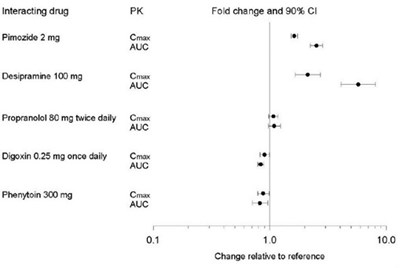
This is a table with information about the fold change and 90% confidence interval for certain drugs and their interactions. The drugs listed are Pimozide, Desipramine, Propranolol, Digoxin, and Phenytoin. There are also some dosages listed, such as 2 mg for Pimozide and 100 mg for Desipramine. However, there isn't enough information to determine what the fold change and confidence interval measures are referring to. The last row may be a reference range.*
figure-3 - figure 3
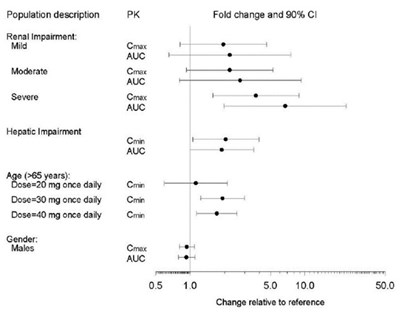
This text seems to be a list of different parameters related to the population description for a study. It includes information about renal and hepatic impairment, age, dose, gender, Cmax and AUC. However, it is not clear what the actual study is about, what the purpose of each parameter is, or what the fold change and 90% CI refer to. Therefore, it is difficult to give a useful description based on this text alone.*
paroxetine - paroxetine label
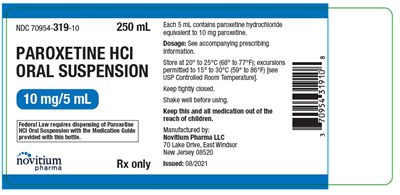
NDC 70954-319-10 250 mL PAROXETINE HCI ORAL SUSPENSION. Each 5 mL contains paroxetine hydrochloride equivalent to 10 mg paroxetine. Federal Law requires dispensing of Paroxetine HCI Oral Suspension with the Medication Guide provided with this bottle. See accompanying prescribing information. Store at 20° to 25°C (68° to 77°F); excursions permitted to 15° to 30°C (59° o 86°F). Keep tightly closed. Shake well before using. Keep this and all medication out of the reach of children. Manufactured by Novitium Pharma LLC. Issued: 08/2021.*
spl-table - spl table
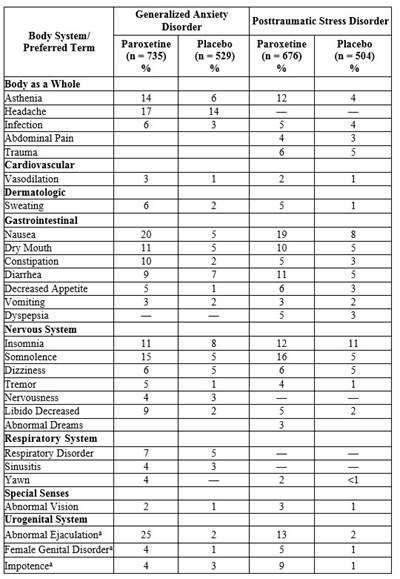
This appears to be a table displaying the percentage of patients who experienced certain symptoms when treated with Paroxetine and Placebo for Generalized Anxiety Disorder or Posttraumatic Stress Disorder. The symptoms are grouped by body system or preferred term, with the percentage of patients who experienced the symptom under each treatment option. Some symptoms mentioned include headache, vasodilation, sweating, constipation, insomnia, and abnormal ejaculation, among others.*
table-1 - table 1
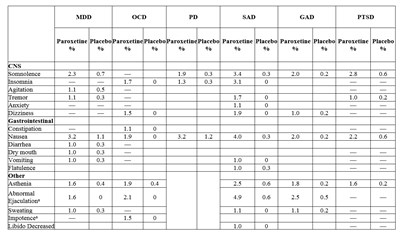
The text appears to be the result of a table with rows and columns listing medication names and some associated symptoms. The medication listed is Paroxetine and the symptoms or side effects are listed in various categories like somnolence, insomnia, agitation, tremor, anxiety, dizziness, gastrointestinal, constipation, nausea, etc. The table displays various percentages and numbers associated with the severity level of each symptom and the medication dosage.*
table-2 - table 2
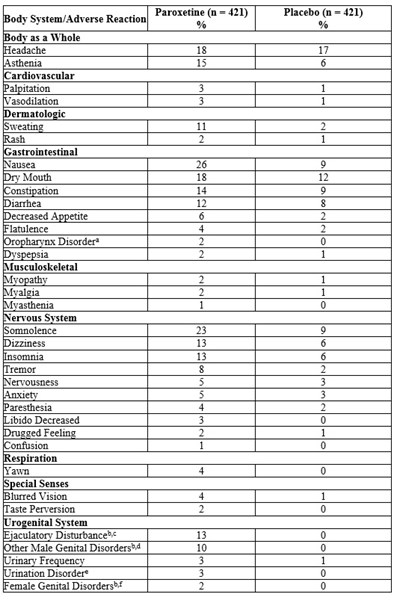
This document appears to be a table listing the percentages of adverse reactions to Paroxetine and Placebo for 421 participants. It describes the effects on various body systems such as "Body as a Whole," "Cardiovascular," "Dermatologic," "Musculoskeletal," "Nervous System," "Respiration," "Special Senses," and "Genital/Urinary." The adverse reactions are listed in the table, with their corresponding percentages for both Paroxetine and Placebo. Some reactions indicated in this table include headache, asthenia, palpitation, sweating, nausea, dry mouth, dizziness, confusion, urinary frequency, and genital disorders.*
table-5 - table 5

This appears to be a chart displaying the incidence of various symptoms experienced by patients taking different doses of the medication paroxetine. The symptoms are divided into categories based on body systems affected. The chart lists the percentages of patients who experienced each symptom within each dose group, as well as a placebo group. Symptoms include sweating, gastrointestinal issues, nervous system changes, special senses, and urogenital issues.*
* The product label images have been analyzed using a combination of traditional computing and machine learning techniques. It should be noted that the descriptions provided may not be entirely accurate as they are experimental in nature. Use the information in this page at your own discretion and risk.



